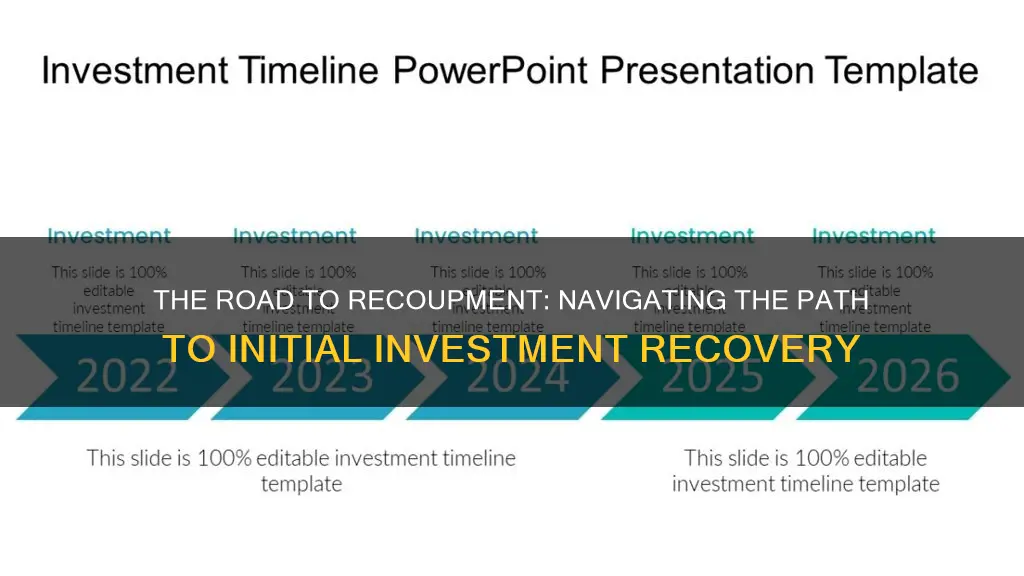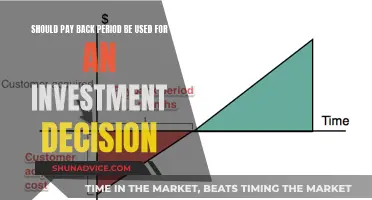
The payback period is the amount of time it takes to recover the initial investment. It is the length of time an investment takes to reach a breakeven point. The payback period is calculated by dividing the amount of the investment by the annual cash flow. The shorter the payback, the more desirable the investment. Conversely, a longer payback period is less desirable. Historical data can be used to estimate how long it will take for investments to recover from a market downturn.
| Characteristics | Values |
|---|---|
| Definition | The payback period is the amount of time it takes to recover the cost of an investment. |
| Importance | The payback period is important because people and corporations invest their money to get paid back. |
| Calculation | The payback period is calculated by dividing the amount of the investment by the annual cash flow. |
| Applicability | The payback period is commonly used by investors, financial professionals, and corporations. |
| Usefulness | The payback period is useful for anyone and helps in making snap judgments about an investment venture. |
| Advantages | The payback period is simple to calculate and helps in determining the most profitable project or investment. |
| Disadvantages | The payback period disregards the time value of money and does not account for the overall profitability of an investment. |
| Alternatives | Alternative methods of capital budgeting include net present value (NPV), internal rate of return (IRR), and discounted cash flow. |
| Considerations | When considering the payback period, it is important to assess the time horizon, risk tolerance, and short-term and long-term goals. |
| Historical Perspective | Historical data can provide insights into recovery times, but it is not a perfect guide as future results may vary. |
What You'll Learn

The payback period is the time it takes to recover the initial investment
The payback period is a crucial metric in investment decision-making, indicating the time it takes to recover the initial investment. It is calculated by dividing the initial investment by the average annual cash flow, and this metric is used by investors, financial professionals, and corporations alike.
The payback period is a simple yet powerful tool for evaluating investments. It helps determine how long it will take to recoup the initial investment, making it easier to compare different investment opportunities. A shorter payback period is generally more attractive, indicating lower risk and quicker recovery of funds. This metric is particularly useful for investors who need to make quick decisions about investment ventures.
For example, if a company invests $1 million in a project expected to yield $250,000 annually, the payback period would be four years. This means that after four years, the company would have recovered its initial investment.
However, one drawback of the payback period is that it disregards the time value of money. This means that it does not account for the earning potential of the invested funds over time. Other metrics, such as net present value (NPV) and internal rate of return (IRR), are often used in conjunction with the payback period to address this limitation.
The payback period is a valuable tool for investors, businesses, and financial analysts to assess the viability of investments and make informed decisions. It provides a straightforward way to evaluate the potential returns and risks associated with different investment opportunities.
The Debt Dilemma: Navigating the Path to Financial Freedom
You may want to see also

Shorter payback periods are more attractive
The payback period is a metric used to evaluate the time it takes for an investment to generate enough cash flow to recover its initial cost. It is calculated by dividing the initial investment by the average annual cash inflows generated by the investment. A shorter payback period is generally more attractive to investors as it indicates that the investment will generate a positive return more quickly.
- Increased liquidity and cash flow: Shorter payback periods allow for quicker recouping of the initial investment, which boosts liquidity and cash flow. This enables investors to reinvest in other projects or cover unexpected expenses.
- Lower risk exposure: Shorter payback periods tend to have lower risk levels compared to longer ones. By recovering the investment quickly, the chances of unforeseen circumstances impacting the project's profitability are reduced.
- Flexibility in decision-making: Short payback periods provide more flexibility in decision-making, allowing investors to adapt and adjust strategies based on the results and returns. This is particularly beneficial in dynamic and competitive markets where quick decision-making is crucial.
- Preferred by investors: Investors generally prefer shorter payback periods as they indicate a quicker recovery of the initial investment. This preference is reflected in the ranking of projects, with those having the shortest payback periods being considered more highly.
- Useful for small investments: The payback period is especially useful for businesses that make relatively small investments. It provides a simple calculation that does not require complex considerations such as discount rates and impact on throughput.
- Simplicity: The payback period is a simple concept to understand and calculate, making it accessible for rough analyses of proposed projects.
- Risk focus: The payback period analysis focuses on how quickly money can be returned from an investment, which is a measure of risk. This allows for a comparison of the relative risk of projects with varying payback periods.
- Liquidity focus: The payback period favours projects that return money quickly, resulting in investments with a higher degree of short-term liquidity. This is particularly useful when long-term returns are uncertain, such as when a business is entering a new market.
The Ultimate Investment: Strategies for Maximum Returns
You may want to see also

Historical data can help determine recovery time
Historical data can be used to estimate how long it will take for investments to recover from a market downturn. Analysts and investors review historical return data to predict future returns and estimate how a security might react to a particular situation, such as a drop in consumer spending. Historical returns are often associated with the past performance of a security or index, such as the S&P 500.
Calculating historical returns involves subtracting the most recent price from the oldest price in a dataset and dividing the result by the oldest price. For example, to calculate the return of the S&P 500 for 2019, one would use the closing prices from December 31, 2020, and December 31, 2021. By subtracting the 2020 price from the 2021 price, and then dividing the result by the 2020 price, we get the return for that period.
Historical data can provide insight into how a security or market has reacted to different variables, from economic cycles to world events. For example, investors might compare the S&P 500 return during the 2020 recession to the returns during the 2008-2009 recession. However, it's important to consider the underlying catalysts for historical returns, as different factors can lead to different outcomes.
While historical data can provide context and inform decision-making, it's worth noting that past results do not necessarily predict future returns. The older the historical data, the less likely it is to be useful for forecasting. Additionally, historical analysis of market and economic trends can yield mixed results due to the dynamic and ever-evolving nature of these systems.
In summary, historical data can be a valuable tool for estimating recovery time and making investment decisions, but it should be combined with other analysis methods and considerations to make more informed choices.
Litecoin: Worth Your Investment?
You may want to see also

Capital recovery is the return of initially invested capital
The payback period is a commonly used method to calculate the time it takes to recover the initial investment. It is calculated by dividing the amount of the investment by the annual cash flow. The payback period is useful for investors, financial professionals, and corporations to determine how long it will take to recover the initial investment.
A shorter payback period is generally more desirable as it indicates a quicker recovery of the initial investment. For example, if an investment has a payback period of 4.2 years, it is considered a good investment. On the other hand, longer payback periods are less attractive as they indicate a longer time to recoup the initial investment.
The payback period is also useful for investors who need to make quick decisions about investment opportunities. It helps them understand the breakeven point of an investment, which is when the revenue generated equals the cost of the investment. However, one downside of the payback period is that it does not take into account the time value of money, which means that it does not consider the earning potential of the invested money over time.
Other methods such as net present value (NPV), internal rate of return (IRR), and discounted cash flow are used to address this limitation by considering the time value of money. These methods provide a more comprehensive understanding of the investment's profitability and potential opportunity costs.
Overall, the payback period is a valuable tool for investors and financial professionals to assess the viability of an investment and make informed decisions about their investment strategies.
Boeing: Invest or Avoid?
You may want to see also

The time value of money is central to capital recovery
The time value of money is a core principle of finance. It is the concept that a sum of money is worth more now than the same sum will be in the future due to its potential earnings. This is because money grows when it is invested, so a delayed payment is a lost opportunity for growth.
For example, if an investor has the option of receiving $10,000 now or $10,000 in two years, the $10,000 today has more value and utility due to the opportunity costs of the delay. This is despite the equal face value of the two options.
The time value of money is also important in capital recovery because it can help investors make decisions about which projects to choose. For example, an investor might have to choose between Project A and Project B. Both projects are identical, except that Project A promises a $1 million cash payout in year one, while Project B offers a $1 million cash payout in year five. Using the time value of money, an investor can determine that the $1 million payout received after one year has a higher present value than the $1 million payout after five years.
The time value of money is also important in capital recovery because it can be used to calculate the payback period. The payback period is the amount of time it takes to recover the cost of an investment. It is calculated by dividing the amount of the investment by the annual cash flow. The payback period is useful for investors and corporations when deciding whether to go through with an investment. However, one downside of the payback period is that it disregards the time value of money.
Retirement Planning: Navigating Investment Strategies as the Finish Line Approaches
You may want to see also
Frequently asked questions
The size of the initial investment, the rate of return or profitability of the investment, the consistency and magnitude of the cash flows generated, inflation, operating expenses, and taxes can all impact the speed of capital recovery.
The payback period is a commonly used method to calculate investment returns. It is calculated by dividing the cost of the investment by the average annual cash flow. The payback period helps determine how long it will take to recover the initial investment costs.
Historical data can provide insights into how securities or markets have reacted to different variables. By analyzing past recovery times for different types of investments, investors can set reasonable expectations for how long it might take their investments to bounce back.
The breakeven point is when total revenue equals total costs, resulting in neither a profit nor a loss. Capital recovery, on the other hand, focuses on making back the initial investment and generating a profit. A company can only experience capital recovery after achieving the breakeven point.







